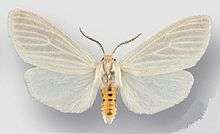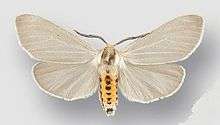Cycnia oregonensis
Cycnia oregonensis is a moth in the family Erebidae. It is found in most of North America, from coast to coast and from the border with Mexico north to central Saskatchewan and Nova Scotia.[1]
| Cycnia oregonensis | |
|---|---|
 | |
| Cycnia oregonensis oregonensis, male | |
 | |
| Cycnia oregonensis tristis, male | |
| Scientific classification | |
| Kingdom: | Animalia |
| Phylum: | Arthropoda |
| Class: | Insecta |
| Order: | Lepidoptera |
| Superfamily: | Noctuoidea |
| Family: | Erebidae |
| Subfamily: | Arctiinae |
| Genus: | Cycnia |
| Species: | C. oregonensis |
| Binomial name | |
| Cycnia oregonensis (Stretch, 1873) | |
| Synonyms | |
| |
The length of the forewings is 19–20 mm. Throughout most of its range, adults are nearly uniform in color and pattern. Subspecies tristis is limited to a small area near Olympia, Washington and is the only known population of this species in Washington west of the Cascades. It is distinctly grayer and less patterned than all other populations.
The larvae feed on Apocynum species.
Subspecies
- Cycnia oregonensis oregonensis
- Cycnia oregonensis tristis Crabo, 2013 (Washington)
gollark: Also, amount isn't boolean.
gollark: * by
gollark: or say it's equivalent to multiplication to 2^x.
gollark: Maybe link to something?
gollark: ↑
References
| Wikimedia Commons has media related to Cycnia oregonensis. |
| Wikispecies has information related to Cycnia oregonensis |
- Crabo, L.G. ; Davis, M. ; Hammond, P. ; Mustelin, T ; Shepard, J., 2013: Five new species and three new subspecies of Erebidae and Noctuidae (Insecta, Lepidoptera) from Northwestern North America, with notes on Chytolita Grote (Erebidae) and Hydraecia Guenée (Noctuidae). Zookeys 264: 85-123. Abstract and full article: doi:10.3897/zookeys.264.4304
This article is issued from Wikipedia. The text is licensed under Creative Commons - Attribution - Sharealike. Additional terms may apply for the media files.